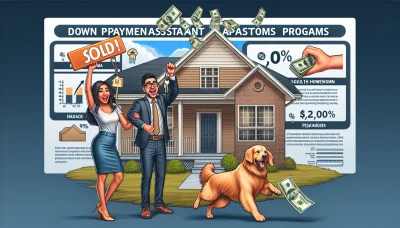Down payment assistance programs texas Quiz
Test Your Knowledge
Question of
Understanding Down Payment Assistance Programs in Texas
Down payment assistance programs in Texas are a lifeline for many aspiring homeowners. These programs provide financial support to help cover the initial costs of purchasing a home. They're designed to make homeownership more accessible, especially for low- to moderate-income families, and to strengthen communities by promoting investment in residential real estate.
With a variety of options available, it's crucial for potential homebuyers to understand how these programs work. By doing so, they can take full advantage of the support offered and navigate the path to owning a home with greater confidence and ease.
Eligibility Requirements for Texas Programs
To access down payment assistance in Texas, applicants must meet certain eligibility criteria. These requirements are in place to ensure that aid is provided to those who need it most. Understanding these prerequisites is the first step towards benefiting from these valuable resources.
The specifics can vary by program, but common factors include income thresholds and household size. Let's dive into these criteria to help you gauge your eligibility.
Income Limits and Household Size
Income limits are a key factor when determining eligibility for down payment assistance in Texas. These limits typically relate to the median income of the area and are adjusted based on household size. It's essential that applicants verify their income falls within the specified range for their family size to qualify for assistance.
Larger households often have higher income thresholds due to greater financial responsibilities. Accurate information about your household size and income is pivotal when applying for assistance programs.
First-Time Homebuyer Status and Education Courses
Many down payment assistance programs in Texas are tailored specifically for first-time homebuyers. A first-time homebuyer is typically defined as someone who has not owned a home in the past three years. This status opens up various opportunities for financial aid that aren't available to repeat buyers.
Educational courses are also frequently required by assistance programs. These courses aim to prepare applicants for the responsibilities of homeownership by covering topics such as budgeting, maintaining a home, and understanding mortgages. Completion of such courses is often mandatory before funds are disbursed.
Types of Down Payment Assistance
The types of down payment assistance available can significantly impact the long-term affordability of a home purchase. Grants and loans each have their own set of benefits and considerations, which we'll explore below.
Understanding the different forms of assistance helps potential homeowners make informed decisions about which type best aligns with their financial situation and goals.
Grants vs. Loans
- Grants: Grants are essentially free money, meaning they don't have to be repaid if certain conditions are met. They're highly sought after but may come with more stringent eligibility requirements.
- Loans: Down payment assistance loans need to be repaid over time but often offer favorable terms such as low-interest rates or deferred payments until the home is sold or refinanced.
- Mistakes to Avoid:
- Assuming you don't qualify without checking: Always review eligibility criteria or speak with a program representativedon't disqualify yourself prematurely!
- Failing to compare options: Look into all available programsgrants, loans, etc.to find the best fit for your needs.
- Ignoring long-term implications: Consider how repayment will affect your finances over time, especially if you choose a loan over a grant.
- Omitting necessary documentation: Be thorough with your application materials; missing documents can delay or derail your chances of receiving assistance.
Forgivable Loans and Deferred Payment Options
Forgivable loans offer an incredible opportunitythey transform into grants if the homeowner meets certain conditions over time, such as occupying the property as their primary residence for a predetermined period. This feature makes them an attractive option among down payment aids.
Deferred payment options are another form of loan where payments are postponed until specific triggers occur, like selling or refinancing the home. This can significantly ease immediate financial burdens on new homeowners, allowing them to stabilize their finances post-purchase before dealing with additional loan repayments.
Exploring State-Wide Assistance Programs
State-wide assistance programs are a beacon of hope for many aspiring homeowners, offering valuable resources and financial aid. These programs are designed to bridge the affordability gap for low-to-moderate-income families, ensuring that the dream of homeownership remains within reach. With a plethora of options available, individuals can find the support they need to navigate the complex home-buying process.
Each state has its unique set of programs tailored to meet the needs of its residents. Texas, for instance, boasts a robust framework of assistance schemes that cater to a diverse range of individuals, including first-time buyers, veterans, and those who have long thought owning a home was beyond their grasp. These programs not only provide financial assistance but also empower buyers with knowledge and tools to make informed decisions.
Texas State Affordable Housing Corporation (TSAHC)
The TSAHC stands as a cornerstone in Texas' efforts to provide affordable housing solutions. It's an organization dedicated to serving those who have served the community, such as teachers, firefighters, and law enforcement officers. Their impact is felt across the state as they work tirelessly to ensure that these vital community members have access to affordable housing options.
Among its offerings are two standout programs: the Homes for Texas Heroes Program and the Home Sweet Texas Home Loan Program. Both initiatives are meticulously crafted to address the specific challenges faced by target groups within the state's population. The TSAHC's commitment is evident in their continuous efforts to adapt and expand their services in response to ever-changing housing needs.
Homes for Texas Heroes Program
The Homes for Texas Heroes Program is a monumental effort by TSAHC to honor those who serve our communities. It provides unbeatable opportunities in the form of grants and down payment assistance for eligible professionals, making homeownership attainable. This program recognizes the sacrifices made by these heroes and offers tangible support as a token of gratitude from the community they protect and serve.
Eligibility criteria are set to ensure that those who contribute selflessly to public welfare can benefit from this initiative. From teachers shaping our future generations to emergency responders safeguarding our streets, this program encompasses a broad spectrum of heroes, acknowledging their roles in creating a thriving society.
Home Sweet Texas Home Loan Program
The Home Sweet Texas Home Loan Program is another jewel in TSAHC's crown, geared towards low and moderate-income residents seeking stable housing solutions. This program not only assists with favorable loan conditions but also provides an avenue for financial empowerment through education on homeownership responsibilities. It's a holistic approach aimed at sustainable homeownership.
With this program, qualifying applicants receive unparalleled support throughout their home-buying journey. The focus is on breaking down economic barriers that often deter individuals from pursuing their own homes, making it an inclusive pathway tailored for broader accessibility.
Texas Department of Housing and Community Affairs (TDHCA)
The TDHCA plays a pivotal role in fortifying Texas' commitment to affordable housing through comprehensive programs like My First Texas Home and the Texas Mortgage Credit Certificate Program. As an agency focusing on housing matters, TDHCA embodies the mission of providing opportunities for fair and affordable housing across all demographics within the state.
The department's initiatives stand out as instrumental in assisting Texans with low-to-moderate income levels achieve homeownership goals. By leveraging funds strategically, TDHCA maximizes impact and fosters transformative change within communities, contributing significantly to the state's overall economic growth.
My First Texas Home
My First Texas Home is TDHCAs flagship program designed specifically with first-time homebuyers in mind. It aims at easing the initial financial burden through low-interest rate mortgage loans and down payment assistance key factors that often pose significant hurdles on the path to buying a home. This initiative paves a smoother road towards homeownership for novices.
By focusing on first-time buyers, My First Texas Home addresses one of the most pressing needs among new entrants into real estate markets - affordability. The program not only opens doors financially but also educates participants about responsible ownershipa critical component for long-term success in homeownership.
Texas Mortgage Credit Certificate Program
The Texas Mortgage Credit Certificate Program offers a unique advantage: it allows homebuyers to claim a tax credit for part of their mortgage interest paid annually. This innovative approach provides ongoing financial relief beyond initial purchase incentives, reinforcing TDHCAs holistic view on supporting sustainable homeownership over time.
This program distinguishes itself by offering an annual benefit rather than just upfront assistance aiding homeowners year after year. It exemplifies TDHCAs foresight in creating enduring solutions that resonate with Texans' long-term financial planning concerning their homes.
- Research Thoroughly: Understand each program's eligibility requirements before applying.
- Gather Documentation: Compile all necessary documents beforehand to streamline your application process.
- Seek Counseling: Take advantage of free or low-cost housing counseling services offered by many assistance programs.
- Mind Deadlines: Be aware of application deadlines to ensure you don't miss out on available aid.
- Budget Wisely: Even with assistance, maintain realistic expectations regarding what you can afford long-term.
- Avoid Scams: Only work with reputable lenders and organizations; if it sounds too good to be true, it probably is.
- Consider Resale: Understand any restrictions on selling your home in the future due to accepting assistance funds.
Local Initiatives for Down Payment Support
City-Specific Programs in Texas
The Lone Star State is brimming with opportunities for prospective homeowners. Texas cities offer diverse down payment assistance initiatives tailored to empower locals in achieving their dream of homeownership. These programs are a beacon of hope, reducing the financial barriers that often deter potential buyers.
Each program is uniquely designed, considering the economic landscape and housing market trends within the city. They can be a game-changer for first-time buyers, offering benefits that range from loans to grants and even counseling services to ensure informed decisions are made.
Houston Homebuyer Assistance Program
Houston is blazing a trail with its Homebuyer Assistance Program, offering robust support to its residents. Eligible Houstonians can receive up to $30,000 in assistance, making the dream of owning a home an attainable reality. The program is not just about financial aid; it's about building communities and securing futures.
Applicants must meet certain criteria, such as income limitations and property qualifications. Moreover, the program mandates participation in homebuyer education classes, ensuring beneficiaries are well-prepared for the responsibilities of homeownership.
Dallas Homebuyer Assistance Program
Dallas's program shines bright with prospects for future homeowners. It stands out by offering substantial assistance that can cover down payment and closing costs. This initiative is a testament to Dallas's commitment to sustainable community development and economic inclusion.
Qualification hinges on factors like income levels and being a first-time homebuyer. Dallas ensures that participants are not left to navigate the process alone by providing essential educational resources aimed at fostering long-term housing stability.
County-Based Assistance Opportunities
Counties across Texas have stepped up, launching down payment support mechanisms that complement city programs. These county-based initiatives work tirelessly towards ensuring that affordable housing isn't just a concept but a concrete reality for many Texans.
The county programs often have broader eligibility criteria, making them accessible to a wider audience. They strike a balance between assisting residents and promoting responsible homeownership through various forms of aid and educational guidance.
Harris County Down Payment Assistance
Harris County's approach to down payment assistance embodies innovation and support. The program extends financial help that significantly lowers the barrier to entry into the housing market for many residents within the county's vast expanse.
- Check Eligibility: Review Harris County's income requirements and property guidelines before applying.
- Understand Terms: Comprehend whether you're obtaining a grant or loan and the terms associated with repayment or recapture.
- Educational Courses: Complete mandatory homebuyer education courses to gain valuable insights into homeownership.
- Maintenance Reserves: Set aside funds for future home maintenance despite receiving assistance; be financially prepared for unexpected repairs.
- Long-Term Planning: Consider how long you plan to stay in your new home since some assistance may require residency for a certain period.
Travis County Housing Finance Corporation
In Travis County, the Housing Finance Corporation stands as a pillar of strength for those dreaming of owning their own home. With innovative programs tailored to serve low- to moderate-income families, they're breaking down barriers one household at a time.
Their offerings include not only monetary aid but also invaluable educational resources aimed at demystifying the complexities of buying a home. Emphasizing both financial and knowledge-based support equips Travis County residents with the tools needed for successful homeownership journeys.
How to Apply for Down Payment Assistance in Texas
Preparing Your Application
Embarking on the journey of homeownership is thrilling, and Texas offers robust down payment assistance programs to help you land your dream home. To prepare your application effectively, begin by familiarizing yourself with the various assistance programs available. Each program has its own set of requirements and benefits, so choose the one that aligns best with your needs.
Gathering the necessary documentation beforehand streamlines the application process. This includes personal identification, proof of income, employment verification, and tax returns. Ensure that all documents are current and accurate to prevent any delays.
Documentation Checklist
- Personal Identification (Driver's License, Passport)
- Proof of Income (Pay Stubs, W-2 Forms)
- Employment Verification
- Tax Returns for the Past Two Years
- Bank Statements
- Credit Report
Credit Score and Financial History Review
Your credit score is a pivotal factor in securing down payment assistance. Aim for a credit score that meets or exceeds the program's minimum requirement. Periodically review your credit report for inaccuracies and resolve any issues promptly.
Analyze your financial history with a critical eye. Lenders scrutinize this to assess risk. Displaying fiscal responsibility through consistent bill payments and a solid savings account can bolster your application significantly.
The Application Process Step by Step
To navigate the application maze with ease, start by pinpointing the right agencies offering down payment assistance in Texas. The Texas Department of Housing and Community Affairs (TDHCA) is a primary resource, providing various options tailored to first-time homebuyers or those meeting specific criteria.
Contacting the Right Agencies
Contact these agencies directly to procure up-to-date information on program specifics and eligibility requirements. Their representatives can offer invaluable guidance, ensuring you understand every aspect of the assistance programs.
Completing and Submitting Your Application
Filling out your application requires attention to detail. Complete each section meticulously to avoid errors that could derail your chances. Double-check for completeness before submission; incomplete applications are often rejected outright.
Submit your application within the specified deadlines, using either online portals or physical submission methods as required by the agency. Keep copies of all submitted materials for your records and follow up regularly to monitor your application's status.
Financial Planning for Homeownership in Texas
Budgeting for Additional Homeownership Costs
When embarking on the journey of homeownership in Texas, it's crucial to look beyond the mortgage payment. Prospective homeowners must budget for a variety of additional costs that can significantly impact their financial stability. These include property taxes, homeowner's insurance, maintenance costs, and potential homeowner association (HOA) fees.
In terms of property taxes and insurance, Texas is known for having higher property tax rates compared to other states. It's imperative to factor these into your monthly budget. Similarly, homeowner's insurance premiums can fluctuate based on location and the type of coverage chosen. Both are non-negotiable expenses that safeguard your investment.
Property Taxes and Insurance
Maintenance and unexpected expenses are also a reality of homeownership. Setting aside funds for regular upkeep helps maintain your homes value over time. However, unforeseen issues like plumbing malfunctions or weather-related damages require an emergency fund to avoid financial strain.
Consider creating a dedicated savings account for these expenses as a proactive measure. This approach ensures you're not caught off guard by sudden repairs or mandatory upgrades that come with owning a home.
Maintenance and Unexpected Expenses
Regular maintenance is less about if and more about when. Texas homeowners should expect periodic expenses such as HVAC servicing, roof repairs, and lawn care. An annual budget for routine maintenance mitigates the risk of larger, more costly problems down the line.
- Set aside 1-3% of your homes purchase price annually for maintenance.
- Conduct seasonal inspections to catch issues early.
- Create a priority list for projects to manage funds effectively.
- Shop around for contractors to ensure you're getting fair pricing on services.
Long-Term Financial Impact of Assistance Programs
The long-term financial impact of assistance programs can be profound for Texas homeowners. Programs such as down payment assistance or mortgage credit certificates can lower initial out-of-pocket costs and may reduce mortgage payments over time.
However, it's vital to understand the qualifications and obligations associated with these programs. For instance, some may require you to reside in the home for a minimum period or repay benefits if you sell the home too soon after purchase.
Effect on Mortgage Payments
Taking advantage of assistance programs often means lower mortgage payments due to reduced principal or interest rate subsidies. This can free up monthly cash flow, allowing homeowners to allocate funds toward savings or investment opportunities.
It's essential to calculate these benefits against any potential costs associated with the program itself. Always consult with a financial advisor or program representative to understand the full scope of how these programs will affect your mortgage payments long-term.
Tax Implications and Benefits
Tax implications are another critical aspect of homeownership assistance programs in Texas. Many programs offer tax credits or deductions which can result in significant savings during tax season.
To fully capitalize on these benefits, homeowners should keep meticulous records of all related expenses and consult with a tax professional who can provide guidance tailored to their specific situation. Maximizing tax benefits can help offset some homeownership costs and contribute to overall financial well-being.
Navigating the Real Estate Market with Assistance Programs
Finding Properties Eligible for Assistance
Stepping into the real estate market can be a game-changer, especially when you leverage assistance programs. These programs are designed to help first-time buyers or those with limited resources secure a home. To maximize these benefits, focus on properties that align with program criteria. This often involves a bit of research, but the rewards think lower down payments and tax credits can be substantial.
Eligibility is key! Not all homes qualify for assistance programs. It's crucial to understand the qualifications which may include price caps, property conditions, or location requirements. By targeting eligible homes from the start, you streamline your search and avoid falling in love with a property that might not fit the mold. Engage with housing agencies or use online tools provided by assistance programs to filter out the perfect match for your homeownership dreams.
Approved Lender Lists
Assistance programs often partner with certain lenders who are well-versed in navigating these specialized loans. An approved lender list is like a treasure map to financing success. These lenders have a track record of working with assistance programs and can guide you through complex paperwork and qualifications. Choosing from this list means you're working with experts who know exactly how to secure the financial aid you need.
Targeted Areas and Special Zones
Many assistance programs give special attention to certain areas or zones places where economic revitalization is encouraged through homeownership. If you're open to location, exploring these targeted areas could unlock additional benefits like higher assistance amounts or more flexible eligibility criteria. It's an opportunity not only for personal gain but also to contribute to community growth.
Working with Real Estate Professionals
The path to homeownership is rarely walked alone real estate professionals are invaluable companions on this journey. Their expertise transforms confusion into clarity, particularly when it comes to leveraging assistance programs. A knowledgeable team ensures that no stone is left unturned in your quest for affordable homeownership.
Choosing a Knowledgeable Realtor
Selecting a realtor who understands assistance programs can make all the difference. They'll identify properties that meet program requirements and will negotiate deals with your best interests at heart. A savvy realtor will be familiar with local market trends and will align their strategies accordingly, ensuring that you get the most out of every available resource.
- Verify Credentials: Ensure your realtor has experience with assistance programs.
- Ask for References: Successful past clients can attest to a realtors expertise.
- Communication Skills: Your realtor should effectively communicate updates and information.
- Local Knowledge: Familiarity with targeted areas and special zones is crucial.
- Negotiation Prowess: A good negotiator can save you money and secure better terms.
The Role of Lenders in Down Payment Assistance
Lenders play a pivotal role in securing down payment assistance for buyers. They not only provide necessary funds but also offer guidance through eligibility requirements and application processes. Aligning yourself with lenders experienced in these programs minimizes roadblocks and streamlines your progress towards closing day. Remember, an informed lender is your ally in translating financial jargon into actionable steps towards owning your home!
Success Stories: Benefiting from Down Payment Help
Real-Life Examples of Program Participants
Across the nation, down payment assistance programs have been pivotal in turning dreams into reality for countless individuals. These programs have provided the necessary boost for many who thought homeownership was out of reach, offering them a substantial leg up in amassing the funds needed for a down payment.
The success stories are not just numbers; they're narratives of people who've overcome financial hurdles. From young professionals to growing families, these beneficiaries often highlight how such programs have changed their lives, giving them a sense of security and accomplishment.
Single-Family Home Purchases
Purchasing a single-family home is a significant milestone made possible for many through down payment assistance. These homes often provide more space, privacy, and the freedom to personalize property without the restrictions commonly found in rental agreements or multi-family housing.
Beneficiaries frequently express how owning a single-family home has allowed them to plant roots and invest in their futures. With the help of down payment programs, they've navigated the complex real estate market and secured homes that meet their long-term needs.
Transition from Renting to Owning
The leap from renting to owning is monumental and often catalyzed by down payment assistance. Former renters celebrate escaping the cycle of renting, where monthly payments build equity for someone else's investment instead of their own.
These new homeowners revel in the pride of ownership and the autonomy it brings. They also benefit from potential tax advantages and the possibility of property value appreciation, which can significantly enhance their net worth over time.
Impact on Communities and the Housing Market
Down payment assistance doesn't just transform individual lives; it has far-reaching impacts on communities and the broader housing market. By enabling more people to purchase homes, these programs can stimulate local economies and contribute to neighborhood stability.
As homeowners invest in their properties, they drive demand for goods and services, supporting local businesses and creating jobs. This ripple effect can be profound, underscoring the importance of such assistance programs not only for individuals but also for economic health at large.
Revitalization Efforts Through Homeownership
Homeownership is often a cornerstone of community revitalization efforts. It fosters community engagement and investment as homeowners are more likely to maintain their properties and contribute to neighborhood improvements.
- Maintained Aesthetics: Homeowners often take great pride in their property's appearance, contributing to overall neighborhood appeal.
- Social Stability: Long-term residents tend to form stronger community bonds and participate more actively in local governance.
- Safety Increases: Neighborhoods with higher rates of homeownership often experience lower crime rates due to residents having a vested interest in community safety.
- Economic Development: Homeownership can lead to increased property values, benefiting both individual homeowners and the community at large through enhanced fiscal health.
Economic Benefits of Increasing Homeownership Rates
Increase in homeownership rates can positively affect local economies by fostering job creation through construction and home improvement industries. Homeowners' ongoing investments in their properties continually fuel economic activity.
The stability provided by homeownership can also lead to improved educational outcomes for children living in owned homes, contributing to long-term economic benefits as these children grow into productive adults. Thus, down payment assistance programs are not merely a helping hand but an investment in future generations.
Future Outlook for Down Payment Assistance in Texas
Changes and Updates to Existing Programs
The landscape of down payment assistance in Texas is on the cusp of transformation. Existing programs are being meticulously reviewed, with a focus on increasing their effectiveness. Amendments to these programs aim to widen the eligibility criteria, allowing more first-time homebuyers and low-income families to benefit.
Updates also include simplifying the application process to ensure ease of access. By streamlining procedures, Texas aims to eliminate bureaucratic barriers and expedite financial support to those in need. This is a game-changer for many potential homeowners who were previously overwhelmed by complex requirements.
Legislative Developments
New legislative measures are being considered to bolster the down payment assistance programs. Lawmakers are actively working on bills that could provide additional state funds, ensuring these vital resources do not run dry. Keep your eyes peeled; these developments could unlock doors to homeownership for countless Texans!
The proposed legislation emphasizes sustainability, aiming for long-term viability of assistance programs. This forward-thinking approach ensures that future generations also have access to the support needed for securing their own homes.
Funding Availability and Program Expansion
The funding pool for down payment assistance in Texas is poised for expansion. Both state and federal funding allocations are expected to increase, giving a much-needed boost to existing programs. More funding means more dreams fulfilleda win-win for Texas communities!
Program expansion efforts are not just about quantity; they're about quality too! Expect enhancements in terms of larger assistance amounts and more comprehensive coverage of home-buying costs. The goal is clear: make home ownership attainable for a broader spectrum of Texans.
Anticipating New Opportunities for Homebuyers
Upcoming initiatives are set to revolutionize the down payment assistance landscape in Texas. We're talking about innovative programs tailored to address the unique challenges faced by modern homebuyers. Get ready for groundbreaking solutions that will redefine the path to homeownership!
New opportunities come with new knowledge requirements. It's crucial for prospective homebuyers to stay informed about emerging programsto seize them as they arise! Stay connected with housing authorities and financial advisors who can guide you through these exciting times.
Emerging Programs and Initiatives
The horizon is bright with the promise of emerging down payment assistance programs designed specifically for Texans' diverse needs. These initiatives are expected to fill gaps left by existing programs, ensuring no demographic is left behind.
Innovation is at the heart of these new initiatives, with technology playing a key role in making them accessible and efficient. We're looking at digital platforms that simplify every stepfrom application to approvalushering in an era of tech-savvy homeownership support.
Collaborations with Private and Nonprofit Sectors
- Expand Reach: Partnerships between government entities and private/nonprofit sectors are set to expand the reach of down payment assistance.
- Increase Funding: These collaborations aim to pool resources, thereby increasing overall funding available to potential homebuyers.
- Innovate Solutions: By leveraging diverse expertise, such partnerships can innovate more effective solutions tailored to community needs.
- Streamline Processes: Collaborative efforts focus on streamlining application processes, making it easier for individuals to obtain assistance.
- Educational Resources: A key component is providing educational resources, ensuring beneficiaries fully understand program benefits and obligations.
- Sustainable Impact: Long-term sustainability is a priority, aiming for lasting impact on housing stability within communities.
- Cultural Sensitivity: Programs developed through collaborations often take into account cultural sensitivities, making them more inclusive.
- Foster Community Growth: These joint efforts contribute not just to individual homeownership but also foster overall community growth and development.












